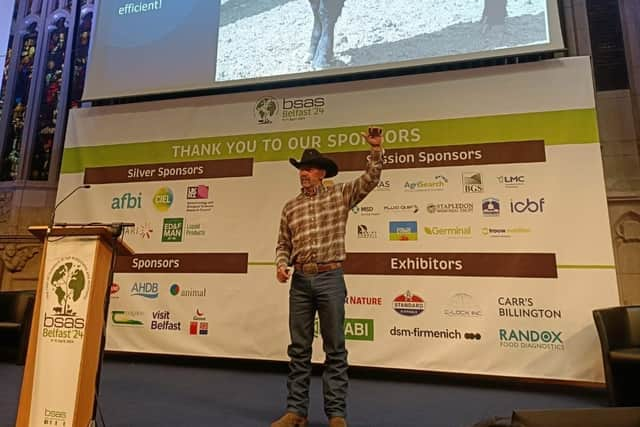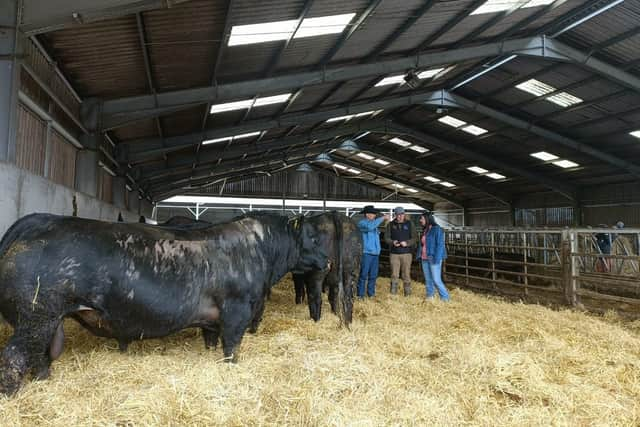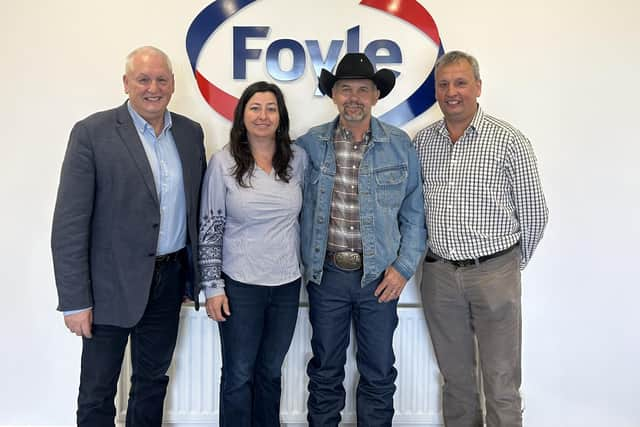Owner of Lucky 7 ranch Jim Jensen guest speaker at BSAS Conference
and live on Freeview channel 276
Jim Jensen, owner of the Lucky 7 Angus ranch from Boulder, Wyoming in the USA was the invited guest speaker for this session.
Prior to the conference, and as part of their visit to Northern Ireland, Foyle Food Group hosted Jim and his wife, Jamie over a number of days, visiting several top pedigree Angus herds in Scotland and England. These included Highland Wagyu (HW) and Netherton Angus, Auchterarder, the Rawburn Angus herd, Kelso and the Aln Angus herd, Alnwick, Northumberland.
Advertisement
Advertisement
On Wednesday 10th April, Jim and Jamie were given an insight to Foyle Food Group with a tour of the Omagh site, from lairage through to further processing. They also were presented to by the Agricultural and Continuous Improvement Managers to gain an understanding of how the teams tackle sustainability challenges and use innovation to improve performance whilst encouraging this within the supply base.


Jim also presented to a number of beef industry representatives including members of the Northern Ireland Aberdeen Angus Breeders Club, Aberdeen Angus Quality Beef (AAQB), agricultural representatives from local banks as well as Foyle suppliers, at an event held at the Foyle Farms of Excellence, Cookstown.
Jim, a fifth-generation rancher, graduate from the University of Wyoming and previous rodeo champion raises 2,500 cows in challenging and harsh conditions of “the Nation’s Icebox”. His grazing paddocks reach up to 38,000 acres and above 10,000 feet in elevation on short grass pastures of the Rocky Mountains. Throughout their lifetime, Jim’s cattle will be trailed over 200 miles across rough terrain and high elevation, they must present structural soundness, good feed efficiency, as well as present adequate carcass traits (conformation).
He focuses particularly on longevity and feed efficiency within his herd and advertises his bulls as being some of the most efficient on the market, with the nation’s first four-year guarantee. Trials are conducted using GrowSafe feed bins where findings have shown that his bulls consume 38.6% less than that of competitors and heifers can maintain body weight with 54% less feed than industry standards.
Advertisement
Advertisement
Jim explained how his heifers are typically calved down at two years of age. However, many fall below this at 21-22 months due to the structure of their calving block for heifers and cows, in January/February and March/April respectively.


The aim within his beef system is to ensure cows are productive for at least 16 years and any cows that are flushed must be a minimum of twelve years of age. This consolidates the longevity and endurance of his cattle with proven genetics. Each year, they breed more heifers than required and will be sold after their first calf if they do not perform well.
Typically, Jim breeds “middle-framed” cows as he believes that “really big cattle, what we call the terminal-cross cattle, don’t last, especially in our conditions”. However, he indicated that feed efficiency is not necessarily correlated with frame size, “we have studied the small-framed cattle that some of the world has said were feed efficient and they’re not good at all.” Similarly, when asked about genotyping to determine more efficient animals, Jim advised that without adequate phenotyping, this cannot be an effective selection mechanism. In addition, Jim emphasised the importance to eliminate the impact compensatory growth may have to ensure accurate feed efficiency.
Addressing the audience with his views on beef as a sustainable commodity, Jim expressed his confidence about how cattle “are the solution, we just (need to) make the engine more efficient”. Although he warned about the progress of the beef industry falling behind its other protein counterparts, he was impressed with the work being carried out in the UK and Ireland to improve this.
Advertisement
Advertisement
In addition to Jim’s presentation at the BSAS conference, Rebecca Rainey, was also a speaker at the event on behalf of Foyle Food Group, discussing the findings from several brush trials. Results showed that by including electronic brushes in cattle pens, this improved daily liveweight gains by 10% (0.21kg/day) and resulted in less aggressive behaviours.


Following the conference, Jim and Jamie also had an insight into research being conducted in the beef sector in Northern Ireland. Facilitated by AFBI and held in Hillsborough, representatives from AgriSearch, Ulster Farmers’ Union, CAFRE and Northern Ireland Agricultural Producers’ Association met and had positive discussions about the current industry challenges and opportunities.
Another guest present was Dinesh Thekkoot from Vytelle, formerly known as GrowSafe feed bins, a precision livestock company. He outlined the capabilities of their data capturing technology including feed and water intakes as well as in-pen weight gain measurements. These have been widely adopted in US feedlots and ranches to identify high performing and feed-efficient individuals.
To conclude their visit, Jim and Jamie visited local farmer Paul Turley, Downpatrick as well as the Gigginstown House stud, Mullingar before returning to the US. He finished off engaging with Irish Aberdeen Angus breeders and Angus Beef Ireland at Mullingar Park Hotel.